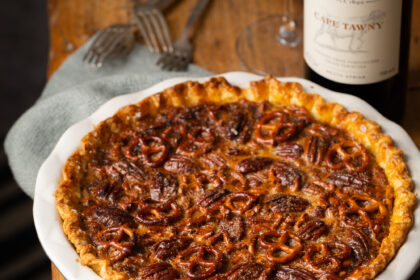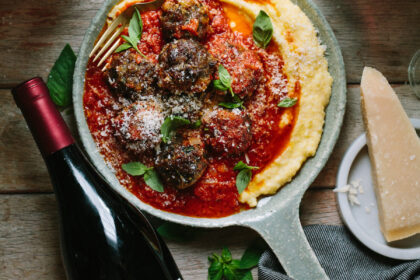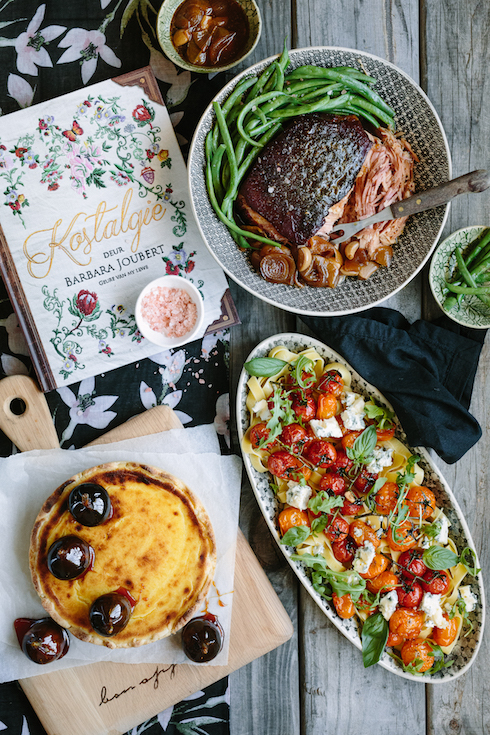
There’s nothing that says “I love you” like a thoughtful, scrumptious and beautiful home-cooked meal. The recipes in Barbara Joubert’s (Afrikaans) book Kostalgie are the perfect choices for a Mothers Day lunch at home, with flavours and influences from her travels all around the world.
I have never made caramelized figs before, and they truly are just magnificent to look at. Almost too beautiful to eat! With the creamy custard tart, they are the stuff dreams are made of.
I love slow roasted pork – it seems to always get raving reviews in my house. I opted for serving the pork with buttery beans instead of potatoes, because of my choice of pasta and tomatoes as a side dish (a stunning meal on its own too).
Have a happy Mothers Day everyone!
Barbara’s book, the homeware and beautiful black floral scarf are all available online and in store from Poetry Stores.
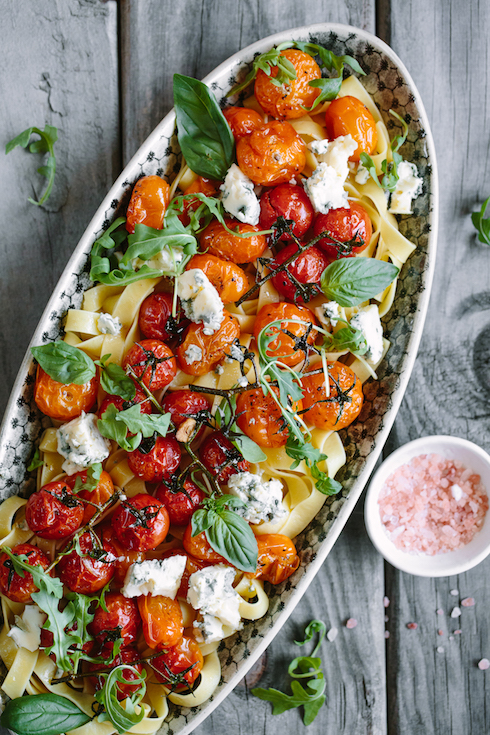
Homemade tagliatelle with burst tomatoes and blue cheese (serves 6)
(Recipe from Barbara Joubert’s Kostalgie)
For the tagliatelle:
300 g (535 ml) cake flour
3 eggs
20 ml olive oil
10 ml water
For the burst tomatoes:
125 ml olive oil
3 garlic cloves
550 g small red and yellow rosa tomatoes
salt and freshly ground pepper
a handful fresh basil leaves
100 g blue cheese
40 g rocket
For the tagliatelle:
Place the flour in the bowl of an electric mixer with dough hook. Make a well in the middle of the flour and add the eggs. Switch the machine on at low speed. Add the olive oil and water. Increase the speed until a soft dough forms. If the dough is too stiff, you can add a little water. Knead for 10 minutes with the machine, then take the dough out and cover with plastic wrap. Let it rest for 1 hour at room temperature. If you have a pasta machine, sprinkle a little flour on your working surface and on the rollers of the machine. Cut the dough into smaller pieces. Set your machine on number 7 and feed the dough through. Set it one setting lower, feeding the dough through until you get to number 1 (the thinnest setting). Hang the pasta sheets over the back of chairs for about 20 minutes to dry out a little. Attach the tagliatelle attachment to the machine, then feed the sheets through the cutter. Place the bundles of cut tagliatelle onto a baking tray sprinkled with flour. Bring a large pot of water to a boil. Add a little olive oil, then add the pasta and cook for 3-5 minutes. Drain and top with the roasted saucy tomatoes.
For the burst tomatoes:
Heat olive oil in a large deep pan. Add the garlic whole and fry for about 2 minutes to flavour the oil. Add the tomatoes and fry until they burst. Season with salt & pepper. Tear basil leaves in pieces and mix with the sauce. Cut slices of blue cheese and arrange on top of the pasta. Sprinkle with rocket and serve.
My notes: A good quality store bought tagliatelle will also work well, if you don’t have a pasta machine.
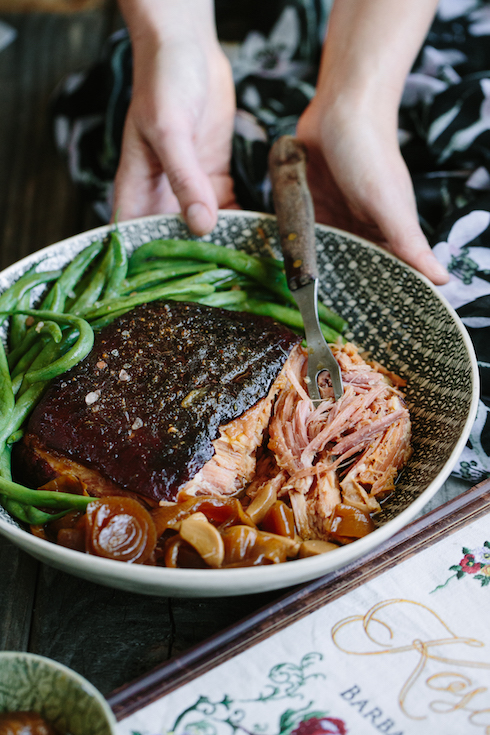
Overnight leg of pork (serves 6)
(Recipe from Barbara Joubert’s Kostalgie)
100 ml olive oil
2 kg leg of pork (I used boneless)
juice of a lemon
3 garlic cloves, finely chopped
salt & freshly ground black pepper
3 bay leaves
250 ml white wine
8 baby leeks
1 x 439 g can chestnuts
Preheat oven to 200 C. Place half the olive oil in a roasting tray. Place the pork in the bowl and sprinkle with the lemon juice. Rub the garlic all over. Season with salt & pepper, then add the rest of the olive oil. Place in oven with skin side down. Remove after 30 minutes, then turn the leg over with skin side up. Cover with foil. Lower heat to 140 C, then roast for 6 hours.
Remove the netting around the meat, then add the bay leaves, wine, leeks and chestnuts. Roast uncovered for an hour at 180 C. Remember the skin won’t be crispy. The meat will be soft enough to pull apart with forks.
My notes: The original recipe calls for leeks, which were unfortunately out of stock everywhere at the time of the shoot, so I substituted these with slices of red onion. I also couldn’t find chestnuts, but I’m sure these will be stocked at a good exotic speciality store.
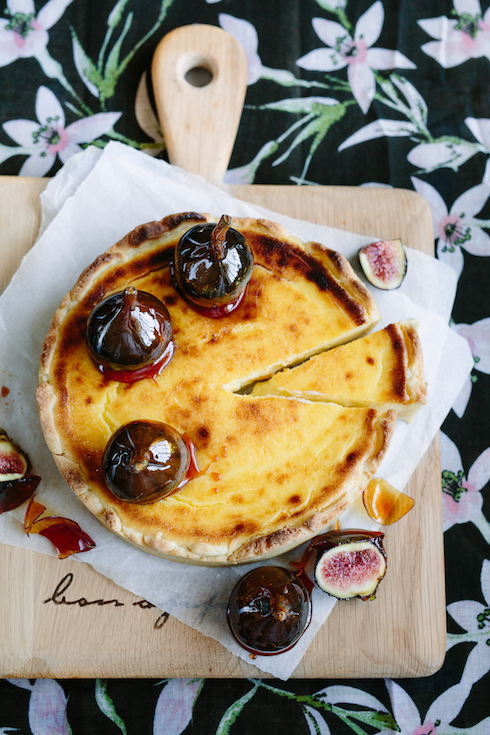
Custard tart with caramelized figs (serves 8-10)
(Recipe from Barbara Joubert’s Kostalgie)
For the dough:
200 g (360 ml) cake flour
50 g (60 ml) caster sugar
100 g (110 ml) unsalted butter, cut into cubes
1 egg yolk
45-60 ml cold water
Place the flour, sugar and butter in a food processor. Mix until the butter is well incorporated. Add the yolk and mix. With the motor running, add the water spoon by spoon, until it just comes together. Remove from mixer and cover with plastic wrap. Rest in the fridge for 30 minutes. Preheat oven to 200 C. Roll out dough on a floured surface. Line a greased 18 cm tart tin with the dough, then prick with a fork all over. Line with baking paper on top and fill with dried beans. Bake blink for 10 minutes at 200 C. Remove paper and beans and bake for another 5 minutes until the base is cooked.
For the filling:
10 egg yolks
20 g (40 ml) cornflour
125 g (150 g) caster sugar
2 ml vanilla powder
200 ml milk
500 ml cream
Whisk the yolks, cornflour, sugar and vanilla together with an electric mixer in a mixing bowl. Heat the milk and cream together in a pot, but don’t let it boil. Add the cream mixture to the egg mixture and mix well. Pour back into the pot, then continue stirring over medium heat until the custard thickens. (You don’t want to make scrambled eggs!) Pour the custard into another bowl and place a piece of wax paper on top to prevent a skin from forming. Let it cool to room temperature. Pour filling in baked tart base and bake for 20 minutes at 180 C. Let it cool overnight, preferable in the fridge.
For the caramelized figs:
500 g (625 ml) sugar
100 ml water
about 25 small figs
Put the sugar and water in a large pot with a lid and place over medium heat until the sugar has melted. Now remove the lid and let it boil until it reaches a light caramel colour. The caramel will continue to darken, so remove from the heat immediately. Carefully dip the figs into the hot caramel and place on a baking tray lined with baking paper to cool. Place on top of the cooled tart when ready to serve.
My notes: The recipe doesn’t mention what size eggs to use, but I found that XL is adequate. I found that I needed to increase the baking time for the base and for the assembled tart to achieve a golden brown result. I couldn’t find small figs, so 9 large ones were enough as a substitute. Don’t caramelize the figs long before you’ll be serving the tart, as the caramel will eventually start to melt as the figs release steam and water, and you’ll be left with syrupy half-coated figs. (Remember, the caramel will harden on standing in the pot, so when you’re done dipping the figs, carefully add some boiling water to the caramel and leave to soften before cleaning.)
This post was created in collaboration with Poetry Stores.

